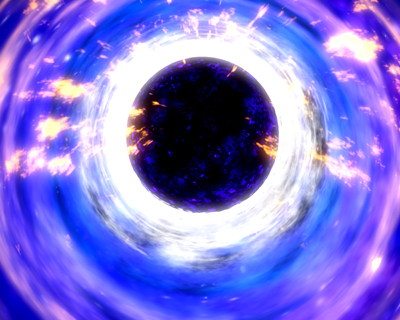This article is more than 1 year old
Galaxy's smallest known black hole discovered
Sand kicked in face, but compacted into infinite density
Two NASA scientists have measured the puniest black hole yet - it has a diameter of just 15 miles and a mass about 3.8 times greater than the size of our sun.
The black hole is located in the Milky Way Galaxy binary system called XTE J1650-500 (oh, NASA and your flowery names) — roughly 10,000 light years away.
Astronomers first located the system in 2001, and knew it housed both a relatively normal star and one featherweight of a black hole. However, until now nobody has bothered to give it an accurate weigh-in.
Today, scientists Nikolai Shaposhnikov and Lev Titarchuk of NASA's Goddard Space Flight Center described the results of their findings.
"This black hole is really pushing the limits," said Shaposhnikov. "For many years astronomers have wanted to know the smallest possible size of a black hole, and this little guy is a big step toward answering that question."
J1650's black hole was measured using a new technique not yet widely adopted by scientists — yet thus far shows the promise of passing scientific scrutiny.
As material is sucked into a black hole, diffused gases form into a spiraling disk that compounds as it nears the center. Just before reaching a black hole's event horizon, the enormous gravitational pressure and friction transform gases into plasma, which radiates a torrent of x-rays. The intensity of the x-rays vary in a pattern that will repeat itself over a somewhat uniform period of time. This signal is called a quasi-periodic oscillation, or QPO.

Finally, a use for that nasty ring around the drain.
Courtesy: NASA
Scientists have already suspected that the smaller a black hole is, the closer gases must be before reaching this point of QPO emission.
Therefore, Titarchuk theorized the QPO pattern would repeat itself more quickly in a smaller black hole. As a black hole increases in mass, the zone is pushed further out and would have a slower QPO.
Shaposhnikov and Titarchuk tested this method last year to three black holes whose masses had previously be estimated using other established techniques.
"In every case, our measurement agrees with the other methods," said Titarchuck. "We know our technique works because it has passed every test with flying colors."
Applying their method to XTE J1650-500, they determined the black hole has a mass of about 3.8 Suns, with a margin of error of about half a Sun. (Half a Sun is approximately 1.9891 x 10^15 kg 9.9446 x 10^29 kg, or about 49.9 per cent of the total mass of our solar system.) Ok, that's huge, but we're talking about a galactic scale here.

XTE J1650-500, envisioned as a Pink Floyd light show
Courtesy: NASA/CXC/A. Hobar
The former title holder of dinkiest black hole belongs to GRO-1655-40, at about the mass of 6.3 Suns.
What makes the discovery fascinating is that there is apparently an unknown size threshold that determines if a dying star will become a neutron star or a black hole. Astronomers believe this boundary is somewhere between 1.7 and 2.7 solar masses. (Meaning Earth will probably won't be destroyed in this particular Jerry Brukheimer-esque fashion.) J1650 lies very close to the minimum size — helping shed light on the behavior of matter as it is compacted into unfathomable density. ®
